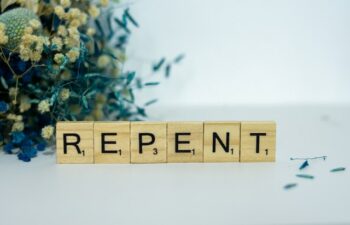
The Forerunner: What Does Repentance Look Like?
About four hundred years before Christ, Malachi (5th century BC) predicted that the prophet Elijah (who lived in the 10th century BC) would return and herald the arrival of the Messiah (Mal. 4:5). In John the Baptist’s day, his people expected the literal Elijah to return from the dead as Messiah’s forerunner. Elijah himself had raised a dead person, so they had some precedent for someone coming back from the dead. The angel’s announcement to Elizabeth and Zechariah identified their baby as the fulfillment of Malachi’s prophecy; he would come in the “spirit and power” of Elijah (Luke 1:17, 76).
During John’s ministry, when asked if he was Elijah, John said, “I am not” (John 1:21).
But Jesus identified John as Elijah (Matt. 11:14; 17:11–13; Mark 9:12–13).
So, which is true? Was John Elijah or not Elijah?
Well…both.
John was not literally Elijah reincarnated or resurrected. When asked about his identity, John told the truth in denying he was the actual prophet Elijah. John was John, not Elijah.
But Jesus, in accordance with the angel’s announcement, identified John as his messianic forerunner, Elijah, because John fulfilled the role assigned to Elijah. In the words of theologian Fleming Rutledge, “When we read the description of John the Baptist in Mark and realize it is the same as the description of Elijah in 2 Kings 1:8 [hairy with a leather belt around his waist], we begin to understand what is going on here. John the Baptist is the new Elijah.”
One spring when my husband and I visited Jordan, we stood where pilgrims throughout church history have commemorated John’s baptism of Jesus. There, I was reminded that events which happened centuries apart often shared the same location. The wilderness where John the Baptist ate locusts is the same location where Elijah ate locusts. As we drove away from the river where John baptized Jesus, we passed the hill from which Elijah was transported.
When people in John’s day went out to the desert to see him, they were heading toward the ancient abode of Elijah. John literally inhabited Elijah’s space. John dressed like Elijah, wore his hair like Elijah, ate desert food like Elijah, and hung out in “Elijah” territory. With that in mind, pay attention to how Matthew records the events:
Now in those days John the Baptist came, preaching in the wilderness of Judea, saying, “Repent, for the kingdom of heaven is at hand.” For this is the one referred to by Isaiah the prophet when he said, “THE VOICE OF ONE CRYING IN THE WILDERNESS, ‘MAKE READY THE WAY OF THE LORD, MAKE HIS PATHS STRAIGHT!’” Now John himself had a garment of camel’s hair and a leather belt around his waist; and his food was locusts and wild honey. Then Jerusalem was going out to him, and all Judea and all the district around the Jordan; and they were being baptized by him in the Jordan River, as they confessed their sins. But when he saw many of the Pharisees and Sadducees coming for baptism, he said to them, “You brood of vipers, who warned you to flee from the wrath to come? Therefore bear fruit in keeping with repentance; and do not suppose that you can say to yourselves, ‘We have Abraham for our father’; for I say to you that from these stones God is able to raise up children to Abraham. The axe is already laid at the root of the trees; therefore every tree that does not bear good fruit is cut down and thrown into the fire. As for me, I baptize you with water for repentance, but He who is coming after me is mightier than I, and I am not fit to remove His sandals; He will baptize you with the Holy Spirit and fire” (Matt. 3:1-11).
John told these spiritual leaders (in no uncertain terms) that the way to prepare for the King’s coming was to repent. That’s still true for us.
Also while in Jordan, we passed below the ruins of Machaerus, Herod’s hilltop palace overlooking the Dead Sea. Beneath that abode, according to Flavius Josephus, John the Baptist sat in a dungeon till Herod ordered him beheaded. All that’s left of the fortress are some marble floors, a few walls, and some pillars. But the snake-infested cave-pits once used as prisons remain. In one of them, below the fortress, John sat rotting in the dark, fighting off literal serpents, and wondering why the new kingdom of God looked nothing like the glory days he’d envisioned.
Despite his bewilderment, though, John remained faithful to death. He feared only God, not the king. Nor the wife of the king. Nor her dancing daughter who asked for his head. Nor the religious leaders. John made known his fearless loyalty; he ultimately forfeited his life rather than allow any power other than God to own him.
John emphasized one thing: “Repent!” And repentance shows fruit.
How does our fruit look? Do we heed the words and example of John? Or are we like the priests of his day, letting power make us deaf to the cries of the spiritually abused? Do we teach a prosperity gospel, saying that most of the poor got there by their own laziness? Or do we care for Jesus Christ in the face of the hungry, the unsheltered, the resident alien, the widow threatened with losing her orphans? Do we use critiques of Critical Race Theory as excuses to yawn at racism? Or do we push past analysis-paralysis to use whatever privilege we have for good? Do we resist true justice, paralyzed by the fear that it might have the word “social” attached to it, or do we actually do justice? Do we cling so loyally to our favorite nation or political party that we overlook its sins? Do we harbor bitterness and speak evil of others, or do we forgive? Do we pride ourselves in loathing the killing of fetuses while downplaying the value of life from birth to old age? Do we demonstrate humility, or are we ruled by selfish ambition? Do we really believe we must decrease, but Jesus must increase?
Excerpted from Latte with Luke.
Photo by Alex Shute on Unsplash




